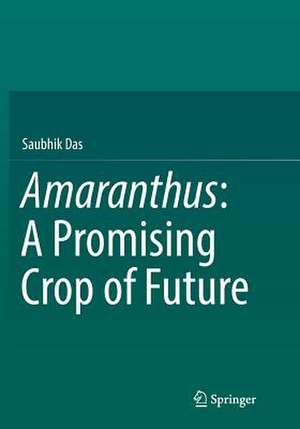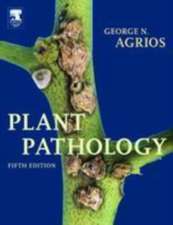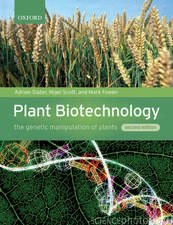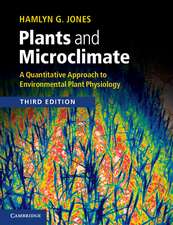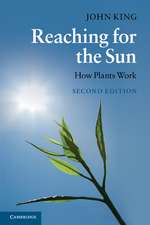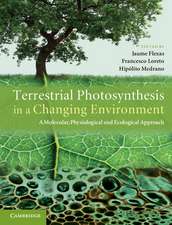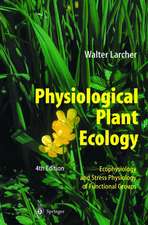Amaranthus: A Promising Crop of Future
Autor Saubhik Dasen Limba Engleză Paperback – 7 iun 2018
Amaranthus is a cosmopolitan genus of annual or short-lived perennial plants. Most of the species are summer annual weeds and are commonly referred to as pigweed. Only a few are cultivated as vitamin-rich vegetables and ornamentals. The protein-rich seeds of a handful of species, known as grain amaranths, are consumed as pseudo-cereals. Amaranthusmanifests considerable morphological diversity among and even within certain species, and there is no general agreement on the taxonomy or number of species. Currently the genus Amaranthus is believed to include three recognized subgenera and 70 species. Amatanthus is considered to potentially offer an alternative crop in temperate and tropical climate.
The classification of amaranths is ambiguous due to the lack of discrete and quantitative species-defining characteristics and the wide range of phenotypic plasticity, as well as introgression and hybridization involving weedy and crop species. It is a known fact that both vegetable and grain amaranths have evolved from their respective weed progenitors. There are more than 180 different weed species that are herbicide-resistant, and amaranths are considered to be leading members of the resistant biotypes. Amaranth species provide ample scope for investigating herbicide resistance mechanisms. Amaranths also show variability in terms of their mating behavior and germplasm, adaptability to different growing conditions, and wide range of variability in sexual systems, from monoecy to dioecy. A solid grasp of these parameters is essential to the future utilization of amaranths as super crops. There are quite a few amaranth research center and germplasm collections all over the world that maintain and evaluate working germplasms. To date, the genetic improvement of amaranths has primarily involved the application of conventional selection methods. But advances in genomics and biotechnology have dramatically enriched the potential to manipulate the amaranth genome, especially improving the amount and availability of nutrients. In conclusion, the book covers all aspects of amaranths, including their food value, significance as vegetables and pseudo-cereals, taxonomy, phylogeny, germplasm variability, breeding behavior and strategies, cultivation practices, and variability in terms of their sexual systems. It offers a valuable resource for all students, researchers and experts working in the field of plant taxonomy and diversity.
| Toate formatele și edițiile | Preț | Express |
|---|---|---|
| Paperback (1) | 639.41 lei 6-8 săpt. | |
| Springer Nature Singapore – 7 iun 2018 | 639.41 lei 6-8 săpt. | |
| Hardback (1) | 646.94 lei 6-8 săpt. | |
| Springer Nature Singapore – 5 aug 2016 | 646.94 lei 6-8 săpt. |
Preț: 639.41 lei
Preț vechi: 752.24 lei
-15% Nou
Puncte Express: 959
Preț estimativ în valută:
122.37€ • 127.59$ • 101.70£
122.37€ • 127.59$ • 101.70£
Carte tipărită la comandă
Livrare economică 21 martie-04 aprilie
Preluare comenzi: 021 569.72.76
Specificații
ISBN-13: 9789811093623
ISBN-10: 9811093628
Pagini: 208
Ilustrații: IX, 208 p. 50 illus., 27 illus. in color.
Dimensiuni: 178 x 254 mm
Greutate: 0.39 kg
Ediția:Softcover reprint of the original 1st ed. 2016
Editura: Springer Nature Singapore
Colecția Springer
Locul publicării:Singapore, Singapore
ISBN-10: 9811093628
Pagini: 208
Ilustrații: IX, 208 p. 50 illus., 27 illus. in color.
Dimensiuni: 178 x 254 mm
Greutate: 0.39 kg
Ediția:Softcover reprint of the original 1st ed. 2016
Editura: Springer Nature Singapore
Colecția Springer
Locul publicării:Singapore, Singapore
Cuprins
1. Introduction.- 2. Pseudo-cereals: an efficient food supplement.- 3. Amaranths: the crop of great prospect.- 4. Infrageneric classification of Amaranthus.- 5. Taxonomy and phylogeny of amaranths.- 6. Weed and Herbicide resistance.- 7. Distribution and maintenance of amaranth germplasm world-wide.- 8. Breeding of amaranth.- 9. Evolution of sexualty in Amaranthus.- 10. Cultvation of Amaranthus.- 11. Future prospects in amaranth research.
Notă biografică
Dr. Shaubhik Das is currently working as Assistant Professor of Botany in Taki Govt. College, Kolkata, West Bengal, India.
His publications:
1. Das, S. and Iamonico, D. (2014). Amaranthus bengalense (Amaranthaceae) a new species from India, with taxonomical notes on A. blitum aggregate. Phytotaxa 181(5): 293-300. (Magnolia Press, Auckland, New Zealand, Impact factor 1.376)
2. Das, S. (2014). Amaranthus parganensis (Amaranthaceae) a new species form West Bengal, India. Novon 23: 406-410. (Missouri Botanical Garden Press, Impact Factor 0.279)
3. Das, S. (2013). Demestication, phylogeny and taxonomic delimitation in underutilized grain amaranths – a status review. Feddes Repertorium 123 (4): 273 – 282 (Wiley-VCH Verlag GmbH & Co.)
4. Das, S. (2013). Infraspecific variability of Amaranthus tricolor (Amaranthaceae) in India with a new variety.
Phytotaxa <88(2): 25-30. (DOI: http://dx.doi.org/10.11646/phytotaxa.88.2.2. (Magnolia Press, Auckland, New Zealand, Impact factor 1.376)
His publications:
1. Das, S. and Iamonico, D. (2014). Amaranthus bengalense (Amaranthaceae) a new species from India, with taxonomical notes on A. blitum aggregate. Phytotaxa 181(5): 293-300. (Magnolia Press, Auckland, New Zealand, Impact factor 1.376)
2. Das, S. (2014). Amaranthus parganensis (Amaranthaceae) a new species form West Bengal, India. Novon 23: 406-410. (Missouri Botanical Garden Press, Impact Factor 0.279)
3. Das, S. (2013). Demestication, phylogeny and taxonomic delimitation in underutilized grain amaranths – a status review. Feddes Repertorium 123 (4): 273 – 282 (Wiley-VCH Verlag GmbH & Co.)
4. Das, S. (2013). Infraspecific variability of Amaranthus tricolor (Amaranthaceae) in India with a new variety.
Phytotaxa <88(2): 25-30. (DOI: http://dx.doi.org/10.11646/phytotaxa.88.2.2. (Magnolia Press, Auckland, New Zealand, Impact factor 1.376)
Textul de pe ultima copertă
This book serves the larger community of plant researchers working on the taxonomy, species delimitation, phylogeny, and biogeography of pseudo-cereals, with a special emphasis on amaranths. It also provides extensive information on the nutritive value of underutilized pseudo-cereals, the goal being to broaden the vegetable list.
Amaranthus is a cosmopolitan genus of annual or short-lived perennial plants. Most of the species are summer annual weeds and are commonly referred to as pigweed. Only a few are cultivated as vitamin-rich vegetables and ornamentals. The protein-rich seeds of a handful of species, known as grain amaranths, are consumed as pseudo-cereals. Amaranthus manifests considerablemorphological diversity among and even within certain species, and there is no general agreement on the taxonomy or number of species. Currently the genus Amaranthus is believed to include three recognized subgenera and 70 species. Amatanthus is considered to potentially offer an alternative crop in temperate and tropical climate.
The classification of amaranths is ambiguous due to the lack of discrete and quantitative species-defining characteristics and the wide range of phenotypic plasticity, as well as introgression and hybridization involving weedy and crop species. It is a known fact that both vegetable and grain amaranths have evolved from their respective weed progenitors. There are more than 180 different weed species that are herbicide-resistant, and amaranths are considered to be leading members of the resistant biotypes. Amaranth species provide ample scope for investigating herbicide resistance mechanisms. Amaranths also show variability in terms of their mating behavior and germplasm, adaptability to different growing conditions, and wide range of variability in sexual systems, from monoecy to dioecy. A solid grasp of these parameters is essential to the future utilization of amaranths as super crops. There are quite a few amaranth research center and germplasm collections all over the world that maintain and evaluate working germplasms. To date, the genetic improvement of amaranths has primarily involved the application of conventional selection methods. But advances in genomics and biotechnology have dramatically enriched the potential to manipulate the amaranth genome, especially improving the amount and availability of nutrients.
In conclusion, the book covers all aspects of amaranths, including their food value, significance as vegetables and pseudo-cereals, taxonomy, phylogeny, germplasm variability, breeding behavior and strategies, cultivation practices, and variability in terms of their sexual systems. It offers a valuable resource for all students, researchers and experts working in the field of plant taxonomy and diversity.
Amaranthus is a cosmopolitan genus of annual or short-lived perennial plants. Most of the species are summer annual weeds and are commonly referred to as pigweed. Only a few are cultivated as vitamin-rich vegetables and ornamentals. The protein-rich seeds of a handful of species, known as grain amaranths, are consumed as pseudo-cereals. Amaranthus manifests considerablemorphological diversity among and even within certain species, and there is no general agreement on the taxonomy or number of species. Currently the genus Amaranthus is believed to include three recognized subgenera and 70 species. Amatanthus is considered to potentially offer an alternative crop in temperate and tropical climate.
The classification of amaranths is ambiguous due to the lack of discrete and quantitative species-defining characteristics and the wide range of phenotypic plasticity, as well as introgression and hybridization involving weedy and crop species. It is a known fact that both vegetable and grain amaranths have evolved from their respective weed progenitors. There are more than 180 different weed species that are herbicide-resistant, and amaranths are considered to be leading members of the resistant biotypes. Amaranth species provide ample scope for investigating herbicide resistance mechanisms. Amaranths also show variability in terms of their mating behavior and germplasm, adaptability to different growing conditions, and wide range of variability in sexual systems, from monoecy to dioecy. A solid grasp of these parameters is essential to the future utilization of amaranths as super crops. There are quite a few amaranth research center and germplasm collections all over the world that maintain and evaluate working germplasms. To date, the genetic improvement of amaranths has primarily involved the application of conventional selection methods. But advances in genomics and biotechnology have dramatically enriched the potential to manipulate the amaranth genome, especially improving the amount and availability of nutrients.
In conclusion, the book covers all aspects of amaranths, including their food value, significance as vegetables and pseudo-cereals, taxonomy, phylogeny, germplasm variability, breeding behavior and strategies, cultivation practices, and variability in terms of their sexual systems. It offers a valuable resource for all students, researchers and experts working in the field of plant taxonomy and diversity.
Caracteristici
Provides a detailed account of taxonomy, phylogeny, breeding, evolution, dynamics of weed and herbicide resistance along with economic importance of Amaranths Discovers the diversity and utility of Amaranths species across the world Introduces and explores Amaranths species as a food crop
